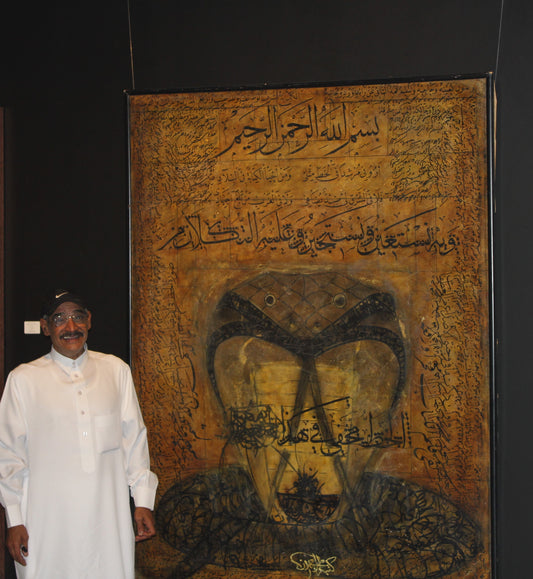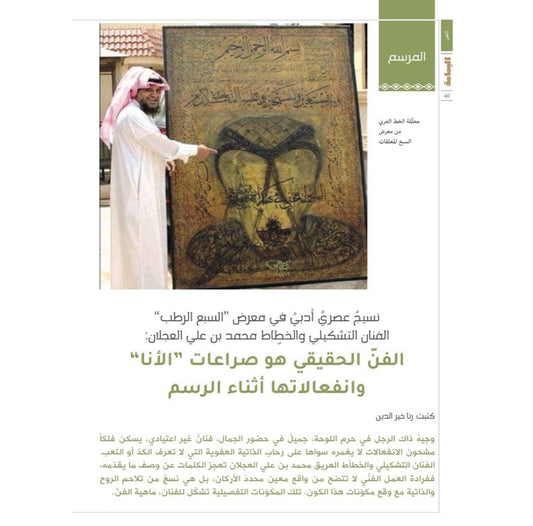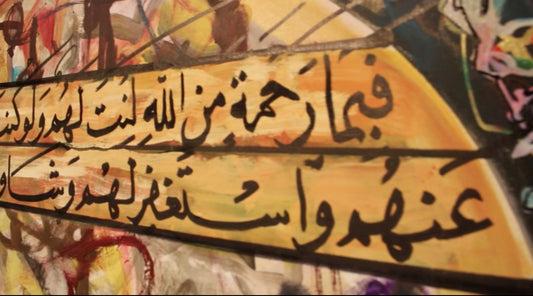
Perhaps it is necessary to meet a fine artist behind the scenes of his art workshop not in a casual meeting in some gallery, and that's what I did one evening. I went to meet the fine artist and calligrapher Mohammed Alajlan, in the office of the good friend Mr. Abdulmohsen AlShweiman in Sharqia Gallery, I was determined to ask some questions, to get a better yet a deeper understanding of his works. So, I asked him: Why did you add in your exhibition of odes a work you named the Arabic calligraphic ode? He looked at me and shrugged seeming uncertain about how to answer my question and kept silent for a moment so did I. Then he said to me: My dream is to make an inclusive work of art of what I feel about the Arabic calligraphy and fine art that make the receiver able to see through the painting canvas and observe the Arabic calligraphy with its forms, sounds, meanings and diacritics and find what he’s looking for in a fine art. But it seems like every time I make a work another one just pops in my head!! We laughed because it sounded like a childish dream of a miracle, then he continued saying “I couldn’t get rid of that dream, not even for a moment!!”
It’s a wonder what makes an artist dream of a painting canvas which carries such energy that enables him to unload his galaxies like gifts? And how could these lines and colors carry such energy? It seems that this particular idea persisted on most of the creative artists’ mind over the human history. I read a book called “Book of Sand” by Jorge Luis Borges which I found very compelling piece of art full of unreadable language of scripts and images. It was not like any other ordinary books; it was remarkable for its ability to give such an endless sustainable energy in each page you read.
Borges didn’t find a suitable place for “The Book of Sand” in his library beside “The Thousand and One Arabian Nights” book, because he knew what the idea of “The Thousand and One Arabian Nights” book was about which was the continuous tales Shahryār told the king, but did not end it forcing him to sheath his sword waiting for the coming one and that’s how Shahryār survived death by her successive endless tales.
Artist Mark Chagall was taken by this idea and he draw sixteen paintings of “The Arabian Nights” but stopped at that point merely because he didn’t understand Shahryār’s secret of immortality way of narration as Borges did in his “Book of Sand” The same idea was inspired by one of the “One Thousand and One Night” heirs artist Mohammed Alajlan who has discovered just the same idea in the ancient Arabian poems and odes. At that time, wherever the Arabian poets wrote a beautiful poem came another poet with another yet more beautiful one and Arabian poets were fund of poetry. they used to attach their poems on the walls of Ka’aba in Makkah until they became seven poems. Some scholars said there were more than the mentioned number, meaning the poets didn’t stop at seven odes.
Mohammed Alajlan saw a unique connection ties calligraphy with fine arts and added his Arabian calligraphic ode using the same idea of the “One thousand and One Night", as he once said: ”whenever I’m done with a work comes up another one, as if it’s not the last of odes nor the last page in Borges’s book or the last tale of Shahryār. That’s Alajlan’s endless dream which burdens him.
If we take a closer look at his art works and try to find the secret of this renewable energy, we will find him translating that same idea, and dream, dissociating the proportionality between the line, point and angle, which is bound by the Arabic character, and forces it to obey the laws of calligraphy, so the letter could become a free form abstract of the word, laws of arithmetic and ratio in calligraphy, but at the same time keeping it as a feather in the gust of wind to form magical signs in an expressive, harmonious, and skilful manner that make letters entangled in beautiful circles and shapes, until it turns into a free dynamic, pushing its way through all the blocks and lines used by the visual art, flat and extended over all the fabric space.
The fact is Alajlan's art is more complicated than that, it is structured in a magical composition. He adopts a double technique to create his magical touch where he frees the letters from the restrictions of mathematical rules of calligraphy by which he unties their lines and shapes, and release them from the visual art rules making those letters free forms like a feather flying in the wind drawing amazing fonts and texts endlessly on blue skies making the painting would look like a stage on which two teams play different rules and yet are harmoniously connected and entangled, such harmony is imposed by a “Maestro”, and the maestro in this case is the free movement of free letters in calligraphy art, without the rules of ratios and arithmetic.
What really distinguishes Alajlan’s art works is the interlocking and entanglement within the letters which casts a living charming entanglement touch that seems to be moving endlessly going beyond the limits of the physical appearance of the painting itself as if it’s taking its magical entangled way to another painting over and over again, and each time he thinks it’s over and about to reach that one night after the thousand or the ode after the seventh one or the last page of the book of sand, he starts the journey all over again.
Dr. Hakim Abbas
December 2009 – Muharram 1431 Hijri



